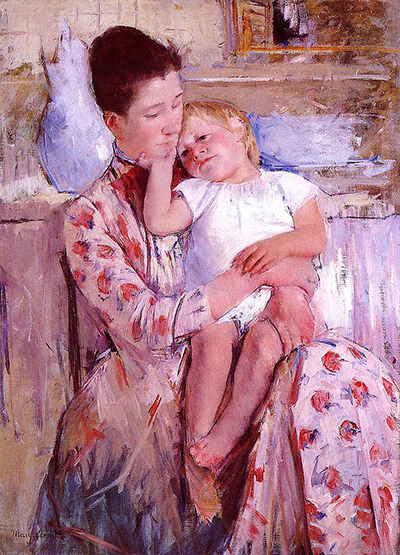Emmie and her Child is actually known by its owners, the Wichita Art Museum, US, as simply Mother and Child but that is a generic title which could apply to many of Mary Cassatt's paintings. The piece is loosely dated at around 1889-1890.
The painting in front of us captures the most common theme found within the artist's career - that of the bond between mother and child. In this case the young boy appears to be of toddler age, when many of her other depictions would make use of younger models. The child is dressed in a simple white outfit which leaves their legs bare as they relax within the family home. The child has blonde hair and a relatively pale complexion, which is the type of look which Cassatt seemed to like the most for her models. The mother holds the child tightly, both for protection and also perhaps to keep them still whilst Cassatt sets about creating the artwork. She has dark brown hair which has been tidied in order to help her go about her daily routine without any distractions. She wears a pretty dress with red patterned motifs over a predominantly white material. It is long and continues into the bottom right corner of the artwork, suggesting she has made a considerable effort in posing for this portrait.
Behind the two figures we find a relatively busy looking domestic setting, in which we can look directly into the life of this woman who no doubt was painted in her own home. Cassatt liked to use her technical talents to draw attention to the women in society who had often been ignored by her male counterparts. Whilst the most glamorous women would feature in exciting compositions, many of the hard working women bringing up the children of the next generation would simply be airbrushed out of history by the art world, and Cassatt wanted to change that. She met some other like minded female artists within the Impressionist collective and they set about correcting this obvious societal oversight. That said, Cassatt would also take on other genres within her career, as the influence of the likes of Degas would encourage her to do, but the mother and child scenes remained her bread-and-butter routines which were also something that she felt particularly passionate about.
One of the important elements to this work is how the child and mother lean towards each other, which increases the atmosphere of bonding. There is also a comfortable relationship between the two, almost as if they are entirely unaware of the artist sat near them. This piece can be found in the Wichita Art Museum, US and they consider it to be one of the highlights of their collection. They have a good selection of American artists here, including other famous names such as Thomas Eakins, Edward Hopper, Winslow Homer and Arthur G. Dove. It may not be the largest or most famous institutions across the nation, but it serves Kansas particularly well and offers an excellent introduction to some of the finest artists in US art history.




